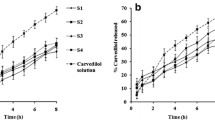Lamotrigine, an antiepileptic agent belonging to class II of the Biopharmaceutical Classification System (BCS), has linear pharmacokinetics and wide therapeutic window thus assisting seizure-free patients to easily switch from brand to generic antiepileptic effect. Cosolvency, micellar solubilization and pH control are powerful techniques for enhancing drugs with poor aqueous solubility problems. The objective of the study was to investigate the solubility of lamotrigine in vehicles considered to be potential vehicles or co-vehicles in the formulation of intranasal solution of lamotrigine. The methodology involved using saturating shake-flask method. After equilibration, the solutions were filtered and analyzed spectrophotometrically. The results show logarithm linear relationships between lamotrigine solubility in water-cosolvent mixtures and cosolvent fraction volume. The solubilization power (σ) or the slope is used to describe the drug-cosolvent-water system. The highest σ value was obtained with ethanol while the most polar cosolvent (glycerol) gave the lowest σ value.With the surfactants, linear relationships between the solubility of lamotrigine in water-surfactant mixtures and surfactant concentration were observed. Solubilization capacities k (obtained from the slopes of the plots) were in the following order: polysorbate 80 (tween 80) > cetrimide > polysorbate 20 (tween 20) > sodium lauryl sulfate. Results of the pH control study indicated that highest aqueous solubility of lamorigine was obtained at pH 10. Micellar partition coefficients of lamotrigine are linearly related to the solubilization free energy. The aqueous solubility of lamotrigine was significantly improved by cosolvency (ethanol), micellization (tween 80) and to a moderate degree by pH control. In summary, the study provided solubility data on lamotrigine in various potential vehicles (or co-vehicles) that could promote formulation of the intranasal solution of lamotrigine.





Similar content being viewed by others
References
R. S. Fisher,W. Van Emde Boas,W. Blume, et al., Epilepsia, 46, 470 – 472 (2005).
S. R. Haut, Curr. Opin. Neurol., 28, 143 – 50 (2015).
J. M. Pellock, J. Child Neurol., 22, 9 – 13 (2007).
H. R. Costantino, L. Illum, G. Brandt, et al., Int. J. Pharm., 337, 1 – 24 (2007).
K. Arumugam, G. S. Subramanian, S. R. Mallayasamy, et al., Acta Pharm., 58, 287 – 297 (2008).
M. M. Migliore, T. K. Vyas, R. B. Campbell, et al., J. Pharm. Sci., 99(4), 1745 – 1761 (2009).
S. Liu, S. Yang and P. C. Ho, Asian J. Pharm. Sci., 13(1) 72 – 81 (2018).
D. P. Wermeling, Neurotherapeutics, 6(2), 352 – 358 (2009).
A. Shende, R. Patil, P. Devarajan, Indian. J. Pharm. Sci., 69(5), 721 – 726 (2007).
G. J. de Haan, P. van der Geest, G. Doelman, et al., Epilepsia, 51, 478 – 482 (2010).
M. G. Harbord, N. E. Kyrkou, M. R. Kyrkou, et al., J. Paediatr. Child Health, 40, 556 – 558 (2004).
M. Lalic, A. Pilipovic, S. Golocorbin-Kon, et al., Drugs R&D, 11(1), 54 – 61 (2011).
M. A. Rogawski and W Löscher, Nat. Rev. Neurosci., 5(7), 553 – 564 (2004).
G. Lees and M. J. Leach, Brain Res., 612(1 – 2), 190 – 199 (1993).
M. J. Brodie, Epilepsia, 35(suppl 5), S41 – S46 (1994).
T. J. Steiner, C. I. Dellaportas and L. J. Findley, Epilepsia, 40, 601 – 607 (1999).
P. Li and L. Zhao, J. Pharm. Sci., 92, 951 – 956 (2003).
C. J. Mbah, Die Pharmazie, No. 6, 322 – 324 (2006).
S. Shafiq, F. Shakeel, S. Talegaonkar, et al., J. Pharm. Biopharm., 66, 227 – 243 (2007).
V. R. Shinde, M. R. Shelake, S. S. Shetty, et al., J. Pharm. Pharmacol., 60(9), 1121 – 1129 (2008).
S. G. Late, S. Gautam, Y. Nikalaje, et al., Int. J. App. Pharmaceut., 12(1), 115 – 122 (2020).
A. F. Azarbayjani, S. Sajed-Aminc, V. Panahi-Azar, et al., Chem. Eng. Res. Des., 105, 64 – 70 (2016).
P. Koteswari, S. Sunium, P. Srinivasababu, et al., Int. J. Pharma Investig., No. 4, 207 – 214 (2014).
A. Shenda and R. Patil, Ind. J. Pharm. Sci., 69(5), 721 – 726 (2007).
L. Zhao, P. Li and S. H. Yalkowsky, J. Pharm. Sci., 88, 967 – 969 (1999).
Y. Ran, L. Zhao, Q. Xu, et al., AAPS Pharm. SciTech., No. 2, 23 – 26 (2001).
S. L. Feldman and M. Gibaldi, J. Pharm. Sci., 56, 370 – 375 (1967).
J. T. Ong and E. Manoukian, Pharma Res., No. 3, 704 – 708 (1988).
C. O. Rangel-Yagui, A. P. Junior and L. C. Tavares, J. Pharm. Sci., No. 8, 147 – 163 (2005).
S. Thorat, Sch. J. App. Med. Sci., 4(8D), 2976 – 2985 (2016).
S. Sweetana and M. J. Akers, J. Pharm. Sci. Tech., 50, 50 – 56 (1996).
Author information
Authors and Affiliations
Corresponding author
Rights and permissions
Springer Nature or its licensor (e.g. a society or other partner) holds exclusive rights to this article under a publishing agreement with the author(s) or other rightsholder(s); author self-archiving of the accepted manuscript version of this article is solely governed by the terms of such publishing agreement and applicable law.
About this article
Cite this article
Mbah, C.J., Onah, C.M. Studies on the Potential Vehicles (Co-Vehicles) for Formulating Intranasal Solution of Lamotrigine. Pharm Chem J 57, 501–506 (2023). https://doi.org/10.1007/s11094-023-02911-3
Received:
Published:
Issue Date:
DOI: https://doi.org/10.1007/s11094-023-02911-3




